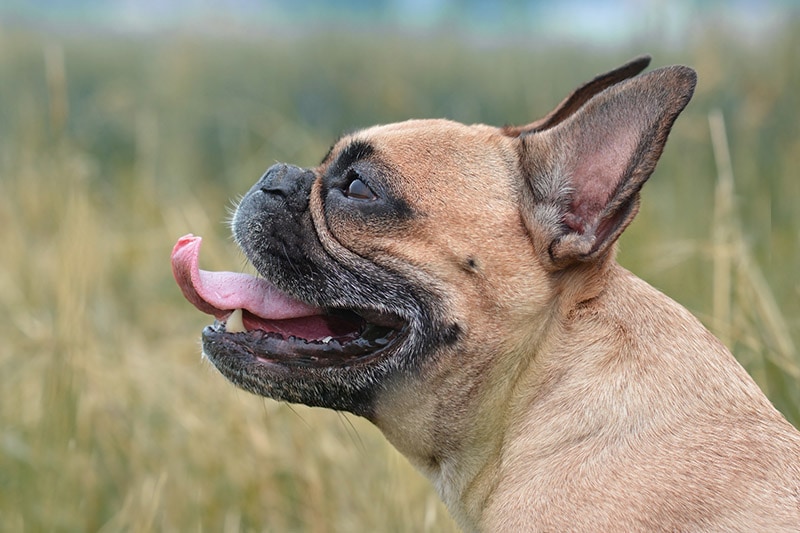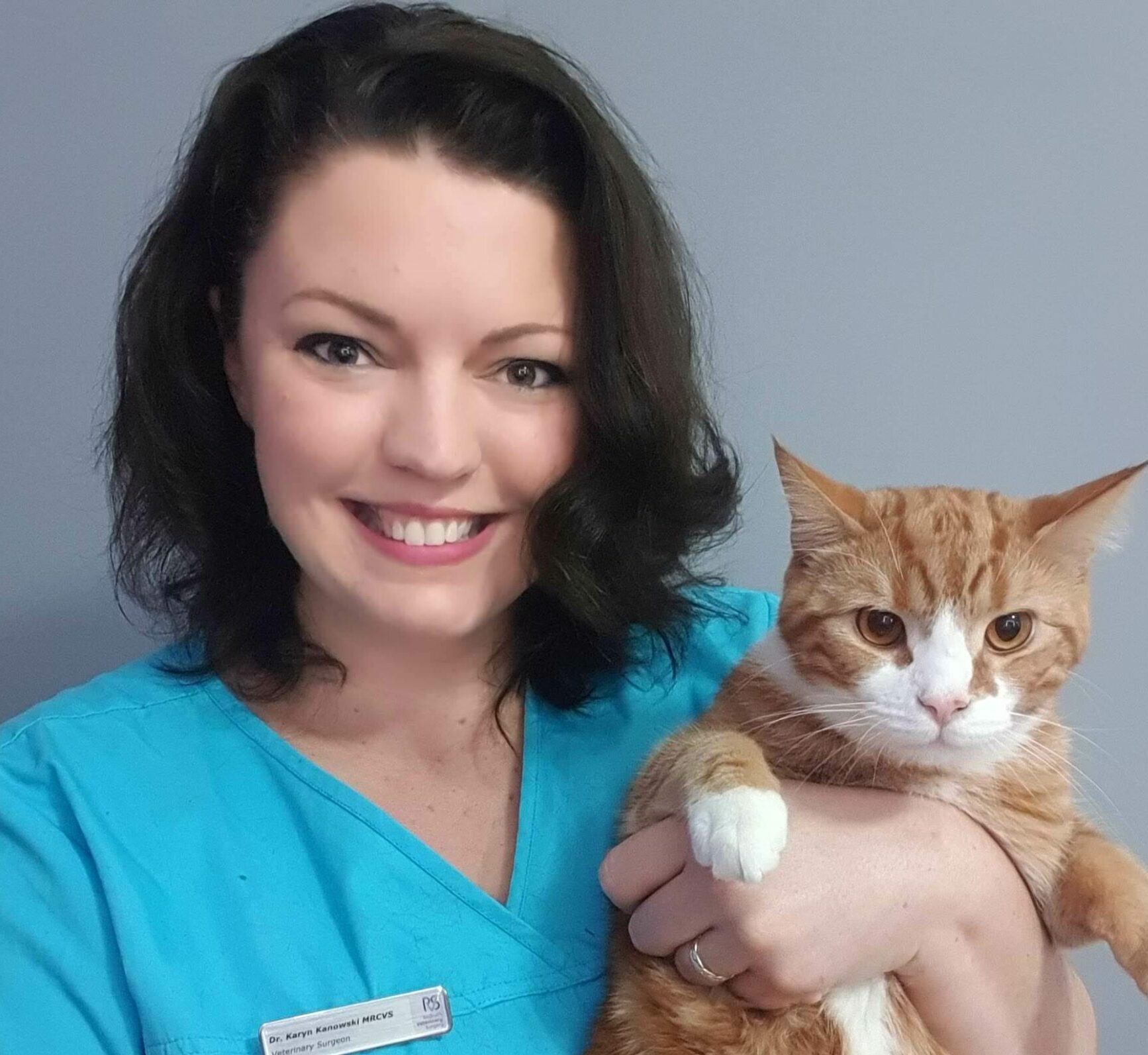Brachycephalic Syndrome in Dogs: Signs, Causes & Care (Vet Answer)

Updated on

Click to Skip Ahead
French Bulldogs, with their big ears, huge eyes, round faces, squishy bellies, and perpetual ‘smile’, are always a favorite on the sidewalk. They attract laughs and giggles with their bouncy personalities. And they tug on heartstrings as they snuffle and snort along, drawing attention both visually and audibly.
They have been bred to look this way, which is, without a doubt, very cute. However, it also means their anatomy is ‘unnatural’ and not particularly conducive to a healthy life. Certain key parts of their nose, mouth, and throat are too big when they need to be small and too small when they need to be big, making it difficult for them to breathe in and out (but especially in).
This article will review these problems and how they create a specific health issue called brachycephalic syndrome.
What Is Brachycephalic Syndrome?
Brachycephalic syndrome is a congregation of defects in a dog’s upper respiratory tract that inhibit their ability to breathe. These defects are a result of their anatomy that has been artificially bred into certain breeds with short, pushed-in noses.
The smushed face of many breeds creates anatomical defects that make it difficult (and even sometimes impossible) for these dogs to breathe, especially when they are bred to the extreme end of the smushed-face spectrum.
Breathing is the first and main problem in brachycephalic syndrome—not being able to get enough air in and out. However, it can also lead to eye, skin, and stomach problems. Dogs with brachycephalic syndrome often have multiple health issues, especially if they are not cared for carefully, with extra attention to detail and effort.
Breeds that are likely to have brachycephalic syndrome are as follows:

What Are the Signs of Brachycephalic Syndrome?
A dog with brachycephalic syndrome will be extremely noisy. Their upper respiratory tract will snuffle, rattle, and snort constantly.
While it is easy to think this is normal since it never stops, it is not. Be careful not to dismiss the cute snuffling noises and exaggerated ‘smiling’ open mouth as harmless and ‘just a personality trait’. It is an anatomical defect that can be life-ending. Signs of brachycephalic syndrome include the following:
- A pushed-in face or smushed-in nose
- Making noise when they breath
- Snoring
- Excessive panting
- Snorting and snuffling
- An overbite
- Tiny nose holes
What Are the Causes of Brachycephalic Syndrome?
There are several causes of brachycephalic syndrome:
1. Nose Is Too Small
Stenotic nares (this is the scientific term for this anatomical defect) where the holes opening to the nose, also called nares, are too small or stenotic. The tiny, stenotic nares in brachycephalic syndrome reduce the amount of air that can enter the lungs when the dog breaths. Imagine how hard it would be to breathe normally through a straw all day, every day, even when you’re running.
Dogs can compensate by also breathing through their mouths; however, there are usually problems with the back of their throat and mouth that also make it hard to breathe.

2. A Tongue That Is Too Large
Many dogs with this syndrome also have a tongue that is too large for their smushed-in face and jaw. Their tongue is particularly thick and gets in the way when the dog tries to breathe.
3. A Soft Palate That Is Too Long
The soft palate makes up the top of the mouth. In the front part of the mouth, the palate is hard, but as it moves further back towards the throat, it becomes soft, hence the soft palate.
When a dog’s face is pushed into the palate, it is too long and jams down into the throat. Once again, getting in the way of the breathing passage.
4. The Trachea Is Too Small
The trachea is the part of the respiratory tract in the throat that travels from the back of the nose/mouth to the lungs. In brachycephalic syndrome, the trachea tube is too small or abnormally narrow in certain places, again creating an effect like breathing through a straw.
The small weak trachea can even collapse, completely obstructing the respiratory tract until it reopens. Tracheal collapse can range from a momentary problem to needing surgical correction.

5. Abnormally Inflamed and Flipped Larynx
Since a dog with brachycephalic syndrome has to breathe so hard and has to suck so much air through all these tiny passages, it predisposes them to inflammation, particularly along the soft palate and larynx, which are made up of soft mucosal tissue.
With that extra air pressure pushing on the larynx, little pockets of mucosal tissue can flip inside out and further obstruct the back of the throat. This extreme development of the syndrome is usually acquired with time as the chronic condition gets worse.
The 10 Ways to Care for a Dog With Brachycephalic Syndrome
1. Talk to your vet about a ‘nose job’ for your dog.
Many dogs with brachycephalic syndrome can be helped by a nose job, boringly called BOAS surgery (brachycephalic obstructive airway syndrome surgery). During this surgical procedure, the nares are widened, the soft palate may be shortened, and the larynx might be trimmed.
Surgically opening the nose and throat can make it easier for a brachycephalic dog to breathe, improving their quality of life, as they can now run and play and enjoy being excited. It can also save their life. Some dogs may even need to have their eyelids ‘done’ as their wrinkly faces can cause eye problems.
2. Keep them cool.

Since dogs also use their respiratory system to cool off by panting. A brachycephalic dog cannot cool themselves off normally and get too hot too quickly. They are prone to heat stress.
3. Monitor their exercise.
Since these dogs cannot breathe normally, they also cannot exercise safely. They struggle to pant and breathe as they run or even play.
4. Keep them calm.
Many dogs pant when they are stressed or excited. If a brachycephalic dog gets stressed or excited, they struggle to pant efficiently and cannot breathe through the stressful event.
5. Keep them a healthy weight.
Unfortunately, many of these dogs are also prone to getting round and overweight. They also look extra cute when they are a little chubby. So, their humans overfeed them to get that cute potato loaf look. However, obesity can make it difficult to breathe all by itself.
6. Use a harness.

Collars do not work well for these dogs because they can exacerbate their breathing problems. And they can even pull so hard their eyes bulge out. Teaching them not to pull on the leash is a behavioral advantage and a health benefit. Harnesses are a must.
7. Control their diet.
The secondary effects on their throat and stomach mean many of these dogs have sensitive stomachs and are predisposed to vomiting. The extra pressure created as they breathe in and out presses on the stomach, predisposing them to GI issues, such as vomiting, acid reflux, and painful tummies.
8. Keep their eyes clean and lubricated.
Since brachycephalic dogs are also predisposed to eye problems because of their extreme anatomy, keeping the eyes clean and lubricated can help prevent problems. Wiping away eye gunk daily keeps the skin around their eyes clean and less inclined to inflection.
9. Keep their noses clean.
The wrinkle around their nose also means that stuff gets in there and the skin does not get aerated, both of which cause irritation and infection. Keeping their wrinkles clean and even applying oil or moisturizer (that is safe for dogs) can help.
10. Be extra vigilant regarding dental health.

Brachycephalic dogs often have bad teeth. Their short jaws do not allow their teeth to grow normally, so they often have overcrowded dental arcades that can be problematic.
Getting regular dental checks and performing preventative maintenance at home can help prolong the need for a complete dental procedure, but at the same time, getting a corrective dental when it is needed is important and should not be put off until the problem gets worse.
Frequently Asked Questions (FAQs)
When should we consider getting surgery?
The sooner, the better! Young dogs not only respond better to the surgery, but they also have less of the chronic changes that occur as a result of the brachycephalic syndrome, so their respiratory tract is less compromised. Even dogs less than two years old do better with surgery than older dogs.
If your dog is diagnosed with severe brachycephalic syndrome the surgery is extra important to do, but at the same time, it is also less likely to work perfectly. If there are more severe problems, that means there is more to correct during surgery which makes it more complicated. And it means there are often more things that the surgeon cannot do anything about regardless.
The surgery usually does not 100% fix brachycephalic syndrome. It makes it some percentage better—90% perhaps or 75%. However, when it comes to breathing oxygen, even the smallest percent can be lifesaving and improve their quality of life by that much.
My dog had surgery, but do they still need medication?
The impact of not being able to breathe and being chronically under-oxygenated is still not fully understood. And many of these dogs have other health problems that could very likely be a result of this condition.
The constant strain of pulling in air as hard as they can irritates the surface of the respiratory tract as well as surrounding structures. Lifelong medication is normal for brachycephalic dogs, even if they have surgery.
What if I want to breed my brachycephalic dog?
This is always an emotionally fraught subject. The reason these dogs have this problem is because they have been bred to have it. Yet, these dogs are so cute and loved that it is hard for people to not want to breed more of them.
The decision to breed a brachycephalic dog is an ethical question that needs to be evaluated individually, considering every dog and every human involved.
These dogs are not only highly maintained, making them difficult for people to take care of, but they also have very complicated births. Most if not all of them need to be delivered by cesarean because their heads are too round and large to be born naturally. So, breeding them is complicated, expensive, and dangerous. Let alone an ethical minefield.
Research, expert experience, veterinary assessment, and breed standards all need to be taken into consideration before breeding these dogs, just like any breed really, but especially with a dog with brachycephalic syndrome.

Conclusion
Brachycephalic dogs are beloved, which is a good thing because they are high maintenance, needing all that extra love and attention, skincare routines, breathing meditation exercises, stress-reducing coping skills—the works. Luckily, most of these dogs would agree that a little bit of self-care is the best.
Featured Image Credit: Firn, Shutterstock















